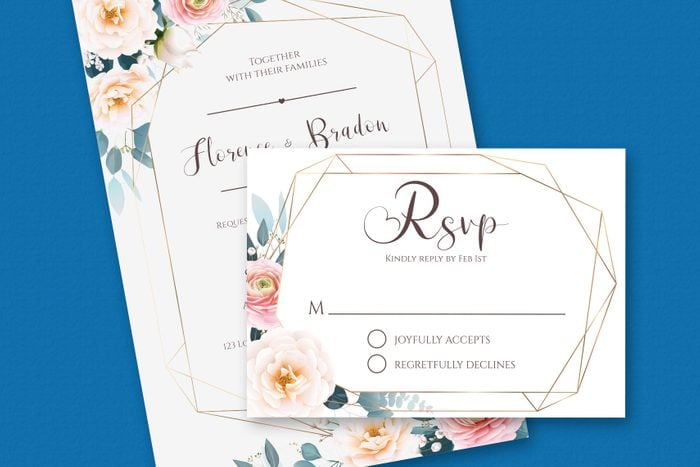What Does RSVP Mean on an Invite?
Updated: Oct. 18, 2023

Even if you know what you're supposed to do, can you answer the question “What does RSVP stand for?”
If you’ve ever hosted a big event like a wedding, you know how important getting RSVPs from all your guests is—it’s wedding etiquette 101. It determines how much food you’ll need to order, how many tables and chairs you’ll need, and how to set up the seating chart so your bickering aunts aren’t right next to each other. Getting those little checked-off note cards back is a pretty big deal. But what does RSVP mean, and what is the best RSVP etiquette?
To avoid any bumps in the road, learning what RSVP stands for and the logistics surrounding it can be extremely beneficial. Grab your invitation and pay close attention, then you can go off and enjoy the celebration worry-free!
What does RSVP stand for?
RSVP is actually a French expression meaning répondez s’il vous plait. That translates to “please respond.” If you ever get an invitation that includes a request for you to RSVP, it means that the host of the party is asking for you to let them know whether or not you will be able to attend.
When to RSVP
Congratulations! You’ve been invited to a wedding or other formal event and received your handy little slip with “RSVP” on it. While mail can get tossed and lost in piles of other not-so-fun mail, it’s important to keep this one aside and know exactly when to send it back. RSVPs are typically due by a certain time to allow the hosts to plan accordingly. These are hard deadlines, so make sure to either do it as soon as possible or make a note of its due date.
Lucky for you, most of the time you have wiggle room on when you can turn it in. Your host(s) will send an invitation out weeks in advance to give you plenty of time to check your calendar and, if need be, clear the time to attend. This gives you an average of four to five weeks to respond, but now that you know the answer to “What does RSVP stand for?” you really have no excuse!
How to RSVP properly
Typical RSVPs come with a stamped and addressed envelope as well as a card for you to record your response on. But more and more RSVPs are being sent through email or online and allow you to respond with one click. RSVP cards vary, depending on the event and the card itself, as some include checkboxes or require a message.
Three elements are typically associated with RSVP cards: names, number of guests and a personalized note. Not all RSVP cards look the same, so before filling anything out, read it through entirely so you understand what needs to be filled out! Some cards will come pre-filled with your information, while others might be a response card that you must fill out yourself (these often come with a prompt on what to write, so don’t worry).
Before returning your RSVP card, make sure you include the following: your name, the names of those in your party, a personal note (if space is permitted) and your entrée choice (if given).
If you cannot attend, don’t ignore the card—fill it out! It’s always best to be honest with the host about your plans, since having some kind of answer is better than nothing. Many people don’t RSVP because they don’t want to hurt the host’s feelings, but an unanswered RSVP usually ends up being more of an inconvenience than a simple “no” would have been. Some RSVP cards say “regrets only.” If you see that, it means you only have to send a response if you can’t attend. Don’t send the RSVP card back if you can attend—even if you want to show your excitement about the event—because that may confuse the host.
How to RSVP via text
These days we use texting for everything from asking people out on dates to letting our boss know we can’t make it in to work, and even sometimes for event planning. But we don’t always know how to RSVP via text. There are occasions when sending an RSVP via text message isn’t a breach of texting etiquette; usually, this will be indicated on your invitation by the inclusion of a phone number. Some hosts may even use an automated RSVP text service to save their personal cell being spammed with dozens of “yes” and “no” messages—you’ll know if they do, because there will be a keyword to include in your text. Of course, if your invite comes via text, it’s perfectly acceptable to text back to accept or decline. But the general rules apply when it comes to how to RSVP via text: include who’s coming, express your excitement and note any dietary issues.
Of course, it’s not always appropriate to RSVP via text, even if you can now answer the question “What does RSVP stand for?” If the invite includes an RSVP card, don’t text—mail it back! In general, it’s appropriate to RSVP to an invite in the same format as you received it. If you were emailed, reply with an email, and the same applies to texts.
Can you change your RSVP?
It’s easy to block off a day and time in your schedule for an event in the future. But while you may have excitedly said yes to attending an event, something unexpected can arise, leaving you unable to go. If your plans have changed, it’s important to make the hosts aware of the situation in a delicate manner, and as soon as you possibly can. They’ll appreciate your telling them!
Additional reporting by Bianca Alvarez.



